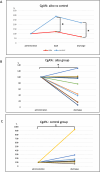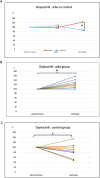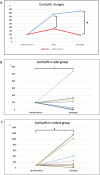Robot therapy aids mental health in patients with hematological malignancy during hematopoietic stem cell transplantation in a protective isolation unit
- PMID: 38413634
- PMCID: PMC10899246
- DOI: 10.1038/s41598-024-54286-4
Robot therapy aids mental health in patients with hematological malignancy during hematopoietic stem cell transplantation in a protective isolation unit
Abstract
Patients with hematological malignancy experience physical and psychological pain, such as a sense of isolation and confinement due to intensive chemotherapy in a protective isolation unit (PIU). We examined whether the intervention of a robotic puppy, aibo (manufactured by Sony), could improve patients' mental health as an alternative therapy for pet therapy, which is not feasible in PIU. This study included 21 patients undergoing allogeneic hematopoietic stem cell transplantation (HSCT) (n = 16) or autologous HSCT (n = 5). The patients were randomly divided into the aibo and control groups. Psychological effects were regularly assessed by measuring the levels of salivary stress hormone chromogranin A (CgA), serum oxytocin, and serum cortisol and the quick Inventory of Depressive Symptomatology Self-Report (QIDS-SR) scores. The aibo group demonstrated a significant decrease in CgA level, while the control group showed the opposite trend. In addition, changes in serum oxytocin and cortisol levels indicated that aibo helped reduce stress. There was no significant difference in the QIDS-SR scores between the two groups; however, the psychomotor activity in the aibo group improved significantly. These findings suggest that aibo intervention during a stay in a PIU can improve the mental health of patients with hematological malignancies who have undergone HSCT.
Keywords: Chromogranin A; Hematopoietic stem cell transplantation; Psychiatry; Quality of life; Robot therapy.
© 2024. The Author(s).
Conflict of interest statement
Akihiko Gotoh has received research support from Taiho Pharmaceutical KK, Chugai Pharmaceutical KK, Nippon Shinyaku, Takeda Pharmaceutical KK, Ono Pharmaceutical KK, Eisai, MSD, Otsuka Pharmaceutical KK, Dainippon Sumitomo Pharma, Bayer, Daiichi-Sankyo, Nihon Pharmaceutical KK, and received honoraria for lecture fees from Novartis Pharma, Alexion Pharma, Eisai, Ono Pharmaceutical KK, Taiho Pharmaceutical KK, Takeda Pharmaceutical KK, Nippon Shinyaku, Chugai Pharmaceutical KK, Otsuka Pharmaceutical KK, Dainippon Sumitomo Pharma, Daiichi-Sankyo, Nihon Pharmaceutical KK, Kyowa Hakko Kirin, Janssen Pharmaceutical KK, Pfizer, Sanofi. The other authors have no conflicts of interest.
Figures






Similar articles
-
Safety and feasibility of electrical muscle stimulation in patients undergoing autologous and allogeneic stem cell transplantation or intensive chemotherapy.Support Care Cancer. 2019 Mar;27(3):1013-1020. doi: 10.1007/s00520-018-4390-z. Epub 2018 Aug 9. Support Care Cancer. 2019. PMID: 30094730 Clinical Trial.
-
[Second allogeneic hematopoietic stem cell transplantation with reduced-intensity conditioning and donor changes in relapsed hematological malignancies after the first allogeneic transplant].Zhonghua Xue Ye Xue Za Zhi. 2023 Jun 14;44(6):465-471. doi: 10.3760/cma.j.issn.0253-2727.2023.06.004. Zhonghua Xue Ye Xue Za Zhi. 2023. PMID: 37550201 Free PMC article. Chinese.
-
Associations of Ficolins With Hematological Malignancies in Patients Receiving High-Dose Chemotherapy and Autologous Hematopoietic Stem Cell Transplantations.Front Immunol. 2020 Jan 28;10:3097. doi: 10.3389/fimmu.2019.03097. eCollection 2019. Front Immunol. 2020. PMID: 32047495 Free PMC article.
-
Efficacy and safety of mesenchymal stem cells co-infusion in allogeneic hematopoietic stem cell transplantation: a systematic review and meta-analysis.Stem Cell Res Ther. 2021 Apr 20;12(1):246. doi: 10.1186/s13287-021-02304-x. Stem Cell Res Ther. 2021. PMID: 33879242 Free PMC article.
-
Decision-analytic modeling as a tool for selecting optimal therapy incorporating hematopoietic stem cell transplantation in patients with hematological malignancy.Bone Marrow Transplant. 2020 Jul;55(7):1220-1228. doi: 10.1038/s41409-020-0784-x. Epub 2020 Jan 13. Bone Marrow Transplant. 2020. PMID: 31932655 Review.
Cited by
-
Robot-Assisted Approach to Diabetes Care Consultations: Enhancing Patient Engagement and Identifying Therapeutic Issues.Medicina (Kaunas). 2025 Feb 17;61(2):352. doi: 10.3390/medicina61020352. Medicina (Kaunas). 2025. PMID: 40005468 Free PMC article.
-
The interplay between physical and mental health and its impact on outcomes for hemopoietic stem cell transplant patients.Curr Opin Hematol. 2025 Jul 1;32(4):187-192. doi: 10.1097/MOH.0000000000000874. Epub 2025 Apr 25. Curr Opin Hematol. 2025. PMID: 40293339 Review.
-
Artificial intelligence in mental health care: a systematic review of diagnosis, monitoring, and intervention applications.Psychol Med. 2025 Feb 6;55:e18. doi: 10.1017/S0033291724003295. Psychol Med. 2025. PMID: 39911020 Free PMC article.
References
-
- Greer, J. P. et al. Wintrobe’s Clinical Hematology (Wolters Kluwer Health Pharma Solutions (Europe) Ltd., 2018).
-
- Gilmer, M. J., Baudino, M. N., Tielsch Goddard, A., Vickers, D. C. & Akard, T. F. Animal-assisted therapy in pediatric palliative care. Nurs. Clin. North Am. 51, 381–395 (2016). - PubMed
Publication types
MeSH terms
Substances
LinkOut - more resources
Full Text Sources
Research Materials

